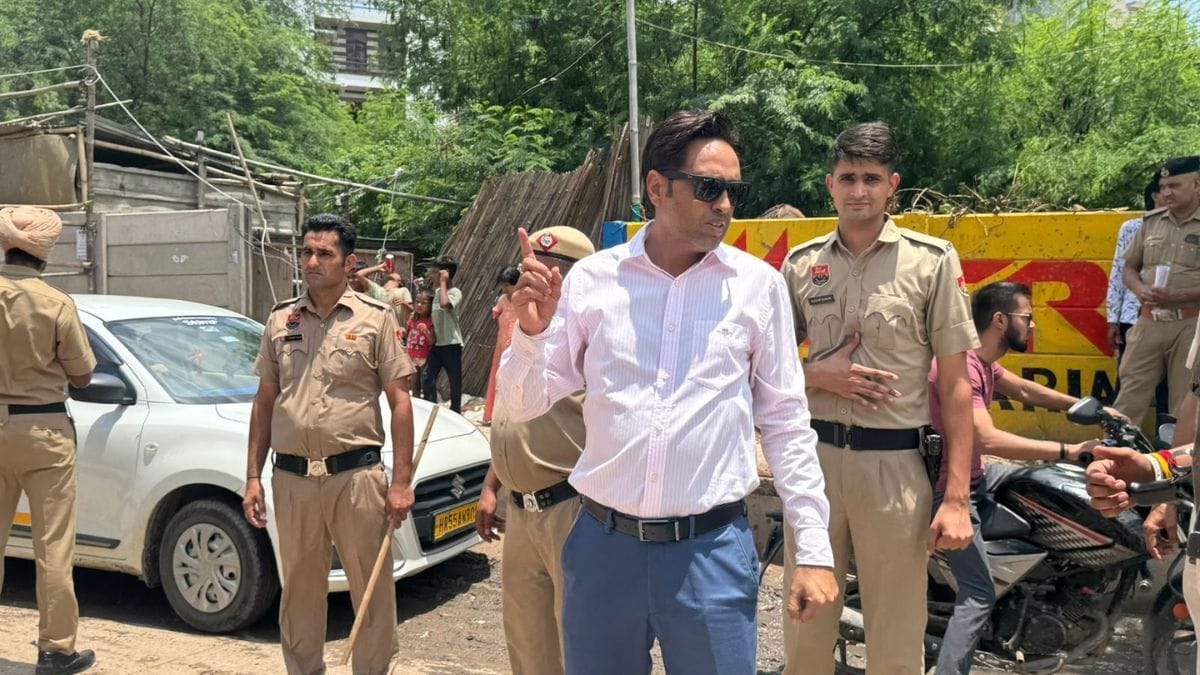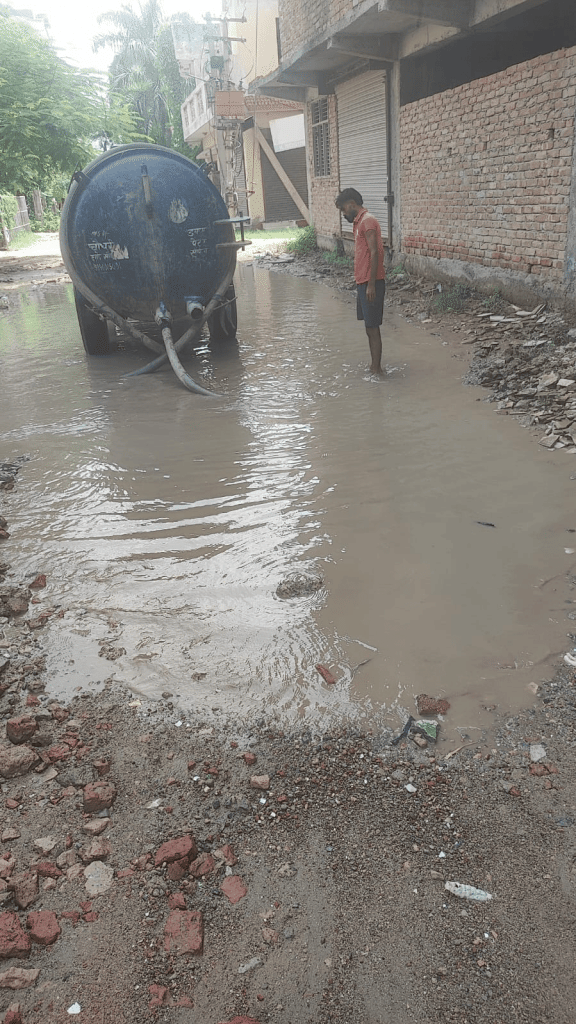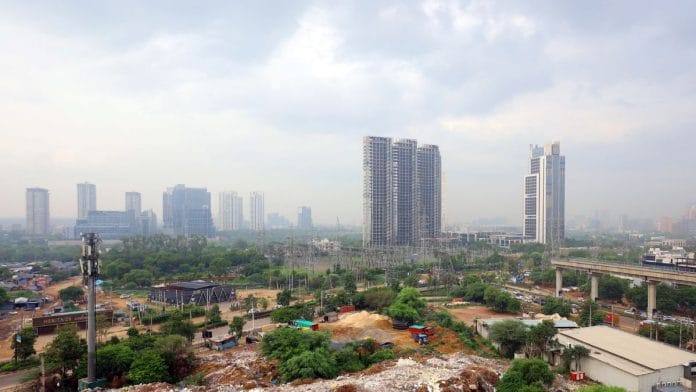Gurugram: On a busy July afternoon in Gurugram’s Sector 45, a JCB ran through hundreds of temporary shops, bringing down tin roofs and dismantling the furniture under them. District Town Planner RS Bhatt thundered, “I will make sure Greater Gurugram is not overrun like this.”
A tall man with a confident posture and an orange tilak on his forehead, Bhatt walked through the shop owners pleading mercy. This is Kanhai village. Tucked between upscale housing societies and the posh neighbourhood of Sushant Lok, the village is home to the city’s migrants, low-income families, and its aspirational middle class. Here, hundreds of roadside shops built on encroached land have been shrinking road width and blocking drainage systems. And Bhatt has a clear mandate: to remove encroachments across the city. He said he had already warned them thrice.
While Bhatt is busy curing the millenium city of encroachments, he has another important task at hand. To prevent such construction doesn’t mushroom in the soon-to-be-carved-out district of Greater Gurugram, talks for which have already begun in power corridors.
As Gurugram makes headlines for its waterlogged roads, mounting waste crisis, and broken urban planning, the Haryana administration is quietly working on a new district — one that will support Gurugram. The district, whose new name is being mulled as ‘Greater Gurugram’, is being seen as a departure from how Gurugram was originally conceived. A New York-style Central Park, a Singapore-inspired SEA aquarium, a Disneyland, a Jungle Safari, and even a dedicated vending zone for street-side businesses. However, the plans of this new district are still in the nascent stages, and there are complaints of basic infrastructure issues by residents in these pockets.
For urban theorist and author Suptendu P Biswas, Gurugram’s urban development has been about “prioritising private over public”. And the grandeur of the ambitious projects is far removed from the ground realities. An approach authorities should avoid in the new yet-to-be-notified district.
Sources in the Gurgaon Metropolitan Development Authority told ThePrint that meetings on the new district have already happened between CM Nayab Singh Saini and former CM and Union Housing and Urban Affairs Minister Manohar Lal Khattar, who has made visits to the district.

Gurugram is broadly divided into two parts — Old and New. Now, the proposed district will include the industrial belt of Manesar, sub-division of Pataudi, Farrukhnagar and Sohna, and the newly developed sectors 81 to 115. Authorities said they are awaiting census and delimitation exercise, following which, the new district is expected to be notified next year.
“New Gurugram or Greater Gurugram, as many call it, is a response to the rapid expansion of population and urbanisation. The idea is that rural, urban and industries should co-exist in this new district and people who are working in Gurugram are able to live in the same city,” said Jitendra Gandhi, Additional Commissioner, Municipal Corporation of Manesar. The Manesar MCD was established in 2020 after it was found that the Gurgaon Municipal Corporation was unable to handle the administrative pressure of the entire city.
But for urban theorist and author Suptendu P Biswas, Gurugram’s urban development has been about “prioritising private over public”. And the grandeur of the ambitious projects is far removed from the ground realities. An approach authorities should avoid in the new yet-to-be-notified district.
“Isn’t Gurugram already Disney-fied with architecture borrowed from anywhere and everywhere! The ambition of privately gated Disneylands has little relevance to the ground realities of basic public infrastructure,” said Biswas, who is the author of ‘Gurgaon to Gurugram: A short biography’.
Also read: Faridabad farmhouses vs Aravallis isn’t over. It’s a war that has just begun
Green spaces, peripheral roads
On 3 August, Union Housing and Urban Affairs Minister Manohar Lal Khattar, along with Minister of Environment, Forest and Climate Change Bhupender Yadav, laid the foundation stone for Matri Van on the Gurugram-Faridabad road in the Aravalli hill region. Spread across 750 acres, the theme-based urban forest will be home to native plants and species, said Khattar.
This van (forest) has been pitched as part of a larger green infrastructure initiative that includes a 10,000-acre jungle safari spanning across Gurugram and Nuh. Both projects are integral to the upcoming ‘Greater Gurugram’ region, said an official of the Gurugram Metropolitan Development Authority (GMDA), a nodal agency that oversees the development and maintenance of Gurugram.
“It will be developed with world-class facilities, making it a popular destination for tourists,” Khattar had said.
With Faridabad in the east, Jajjhar in the west and Nuh and Rajasthan in the South, it will serve as a gateway for Delhi, Gurgaon and Rajasthan.
On the same Gurugram-Faridabad road, another big ticket project is coming up, with the Aravalli hillocks and natural streams in the backdrop — Anand Van. Its design is inspired by New York’s Central Park. Anand Van will span 125 acres of HSIIDC land.
While Gurugram is known as an IT hub, Greater Gurugram is being developed with an eye on tourism.
Along the Dwarka Expressway—the dedicated arterial link between areas of ‘Greater Gurugram’ and the national capital—plans include a Disneyland, a large aquarium inspired by Singapore, and a dedicated vending zone for street-side businesses, all positioned to draw visitors, according to the GMDA official quoted above.
“This is how Greater Gurugram will stand on its own. It will no longer rely on Gurugram. It will have its own identity,” said another senior GMDA official.
With Faridabad in the east, Jajjhar in the west and Nuh and Rajasthan in the South, it will serve as a gateway for Delhi, Gurgaon and Rajasthan.
“Of late, the real estate bubble appears imminent, as expansion spreads into the hinterland, producing high-priced, low-occupancy, sprawl-like development. This is a clear testament to a deeper systemic failure to be addressed urgently, before it becomes irreversible,” said Biswas, who has worked on public space design and landscape urbanism in Indian cities.
The zone’s direct connectivity to the Indira Gandhi International Airport via the Dwarka-Gurgaon Expressway has already attracted interest from major real estate players, including DLF, M3M, Signature Global, and Vatika in New Gurugram — sectors along Dwarka Expressway. Some of these projects span over hundreds of acres and include integrated townships, retail complexes, and luxury housing, said a real estate developer.
Earlier, people moved to Greater Gurugram out of compulsion. Now, they are doing it with the intent to invest and settle.
The hospitality sector, too, is becoming part of the new growth hub. In July, Vivanta by Taj announced to open a 160-room property in Sector 95A. Big brands landing in these new pockets has meant a significant jump in prices of real estate and commercial spaces.
According to property consultant Anarock, housing prices on the Sohna road have seen a sharp rise of 54 per cent since 2022, and the average rental values have increased by 40 per cent.
The region’s accessibility will be further enhanced by the proposed metro service and the Southern Peripheral Road (SPR) that would connect Gurugram to Greater Gurugram and the Dwarka Expressway. The metro line is expected to be a long 28-km corridor connecting the two Gurugrams via 27 stations—from Millennium City Centre to Cyber City. The first leg of the metro corridor between Millennium City Centre and Sector 9 has already been given to the Dilip Buildcon-Ranjit Buildcon joint venture that will construct the first 14 metro stations.
“It will only take 20 minutes to reach IGI airport, so why will it not attract investors,” said a senior GMDA official who was part of the meetings between Saini and Khattar.
Also read: Brand Bengaluru is stuck on bad roads. MNCs, startups are saying ‘Hello Hyderabad’ now
Teething challenges
For the past week, Advocate Seema Nain has been registering complaints on interrupted water supply on the GMDA portal and calling the Junior Engineer. While the complaints are being acknowledged and the Junior Engineer continues to offer assurances, no help has arrived yet. Nain lives in New Palam Vihar, Sector 110 — a locality that will be part of the ‘Greater Gurugram’.
While big projects continue to make headlines, work remains to be done on the ground — especially when it comes to basic civic infrastructure.
“The government is talking about big projects like Disneyland, green parks, and smart cities. But on the ground, they aren’t even able to provide us with basic amenities like roads, electricity, and water,” said Nain, 36, who bought a 3BHK in a plotted society in Sector 110 five years ago.
A society WhatsApp group on Nain’s phone is constantly buzzing with messages from neighbours requesting water. A few residents have even dug borewells to meet their daily needs.
“Do you understand the kind of desperation we go through? People are digging borewells and begging neighbours for water,” said Nain.
The road outside Nain’s house is reeking with sewage that has spilled onto the street. Long electricity outages have become routine.

“I’m a mother of two — a nine-year-old and a four-year-old. I don’t let them step out to play because they could catch infections from the sewage water,” she added.
Her decision to invest in a house here was driven by reports and social media buzz around the upcoming township along the Dwarka Expressway.
“My husband is an aeronautical engineer at IGI Airport, and I practice at the district court in Gurugram. We thought the Dwarka Expressway would be the perfect location for us. Everything we read said it was going to be the next big thing,” said Nain.
To make ‘New Gurugram’ a well-planned district, the administration had sought inputs from Resident Welfare Associations (RWAs) to have a deeper understanding of what is lacking and what is required. The list of concerns ranges from basic necessities such as the absence of government primary healthcare facilities, road connectivity and the need for more ATMs, to co-working spaces and cafes.
Navy veteran Captain KK Sharma, who paid Rs three crore for a 4BHK in a group housing society in Sector 111 in 2016, said the 33KV power sub-station promised to the area is yet to be constructed.
“We have been regularly approaching the authorities. The demand for a substation has been pending for long. Since we live in a gated society, it’s still somewhat bearable as there is a backup — but even that faces outages at times,” he said.
Outside his society, the reality is different. Roads are strewn with garbage, large patches remain waterlogged, and the drainage system is broken.
“The stormwater drainage system here is not connected to the main highway drainage. We’ve repeatedly sent reminders to the authorities, but no one is listening,” said Vivek Rana, RWA member of Diplomatic Greens, Sector 111.
GMDA officials said that soon, the drainage work will start in the ‘New Gurugram’ area to ensure that the streets aren’t waterlogged and water is drained out smoothly. Sectors with poor drainage systems have been identified: Sector 68, 115 and 112, among others.
“Stormwater master drains are being planned. We will first and foremost start working on the drainage before anything else. These drains will collect the rainwater and carry it away to prevent waterlogging,” said a GMDA official quoted earlier in the story.
Biswas described this neglect of basic amenities as a “reactive response by public agencies”.
“There has been utter disregard for natural infrastructure—the topography and landscape of water channels, canals and lakes that historically managed rainwater. In effect, the city was built against nature, resulting in severe waterlogging and flooding during the monsoon season,” he said.
Also read: Indian cities are turning to IITs, tech startups, drone data to solve urban flooding
The challenges
The movement of residents buying homes in the New Gurugram area began around 2018, according to real estate brokers. Back then, the area—far from the main city—was largely deserted. But the promise of the upcoming Dwarka Expressway sparked interest.
When Nain bought a plot in Sector 110 in 2019, it was priced at Rs 1 crore; today, its value has risen to Rs 3 crore. Similarly, Sharma had purchased an apartment in a group housing society for Rs three crore, which now holds a market value of Rs 5 crore.
But for real estate brokers, New Gurugram is heading towards the same fate as Gurugram’s older pockets — marked by massive urbanisation and haphazard planning.
“The sectors in New Gurugram areas are mostly plotted societies under the Deen Dayal Jan Awas Yojana. These four-storey houses are built along 30-metre roads with no parking space. Many are constructed over drains. You can well imagine what the future of these sectors will look like,” said Anoop Jain, a real estate broker.
Bhatt, however, said the administration has ensured that the main sector-dividing roads are 84-metre wide with 12-metres + 12-metres on either side – for service lanes, green buffers. Old Gurgaon only had 30-metre-wide roads. This will make a huge difference,” said Bhatt.
Bhatt made an important observation on the new zone of development. Earlier, people moved to Greater Gurugram out of compulsion — now, they are doing it with the intent to invest and settle, he said.
Meanwhile, on Reddit, people are looking for place recommendations in ‘New Gurugram’. An anonymous account posted a question saying they have moved to Sector 93 out of compulsion, and asking whether there were any places to socialise.
“Wider roads, Aravalli nearby and IGI airport”, read a response.
(Edited by Anurag Chaubey)






